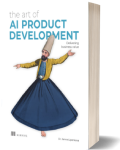The Art of AI Product Development
Artificial Intelligence
Book Details
Book Title
The Art of AI Product Development
Author
Janna Lipenkova
Publisher
Manning Publications
Publication Date
2025
ISBN
9781633437050
Number of Pages
368
Language
English
Format
File Size
3.5MB
Subject
ai-product-development
Table of Contents
- The Art of AI Product Development
- Brief Contents
- Contents
- Preface
- Acknowledgments
- About this Book
- About the Author
- About the Cover Illustration
- Part 1: Discovery
- Chapter 1: Creating value with AI-driven products
- 1.1 Building with AI: The reality check
- 1.2 A retrospective
- 1.3 The anatomy of an AI system
- 1.4 Learning with this book
- Chapter 2: Discovering and prioritizing AI opportunities
- 2.1 Sourcing AI ideas and opportunities
- 2.2 Prioritizing AI opportunities
- 2.3 Shaping your opportunities
- Chapter 3: Mapping the AI solution space
- 3.1 Data
- 3.2 Different types of intelligence
- 3.3 User experience
- Part 2: Development
- Chapter 4: Predictive AI
- 4.1 Unsupervised learning
- 4.2 Supervised learning
- 4.3 Time series and trend analysis
- 4.4 Personalized recommendations
- Chapter 5: Exploring and evaluating language models
- 5.1 How language models work
- 5.2 Usage scenarios for language models
- 5.3 Mapping the language model landscape
- 5.4 Managing the language model lifecycle
- Chapter 6: Prompt engineering
- 6.1 Basics of prompt engineering
- 6.2 Few-shot prompting: Learning by analogy
- 6.3 Injecting reasoning into language models
- 6.4 Best practices for prompt engineering
- Chapter 7: Search and retrieval-augmented generation
- 7.1 Specializing your language model with custom data
- 7.2 Retrieving relevant documents with semantic search
- 7.3 Building an end-to-end RAG system
- Chapter 8: Fine-tuning language models
- 8.1 Uncovering opportunities for fine-tuning
- 8.2 Fine-tuning language models for different objectives
- Chapter 9: Automating workflows with agentic AI
- 9.1 Providing language models with access to external tools
- 9.2 Assembling the agent system
- 9.3 Building at the frontier of AI agents
- 9.4 Trends and opportunities for AI agents
- Part 3: Adoption
- Chapter 10: AI user experience: Designing for uncertainty
- 10.1 Discovery and user research
- 10.2 Designing the UI
- 10.3 Collecting feedback and co-creating with your users
- Chapter 11: AI governance
- 11.1 Security: Protecting sensitive assets
- 11.2 Privacy: Maintaining trust through transparency
- 11.3 Mitigating bias in AI systems
- 11.4 Providing transparency
- 11.5 A proactive approach to AI governance
- Chapter 12: Working with your stakeholders
- 12.1 Efficient cross-functional collaboration in the AI team
- 12.2 Getting buy-in from business stakeholders
- 12.3 Communicating with customers and users
- Appendix: AI development toolbox
- Index
